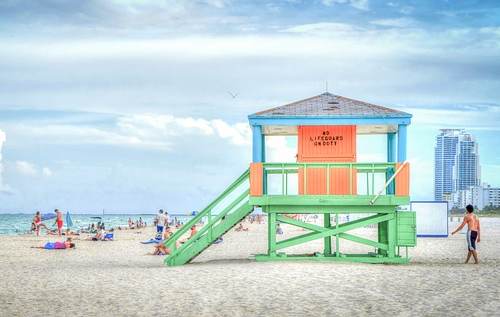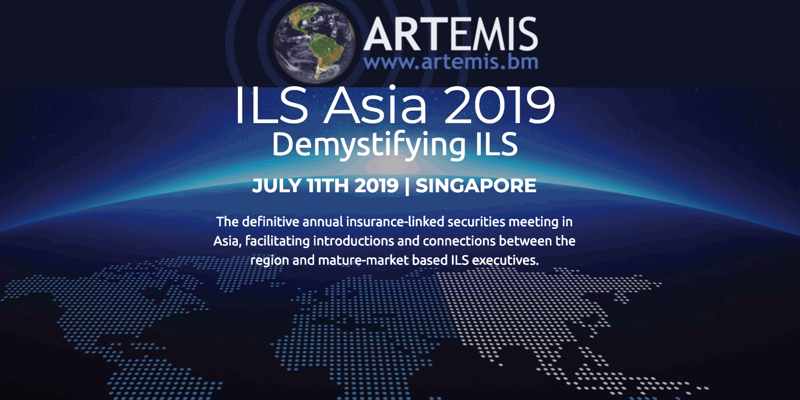Despite the consecutive year’s of major catastrophe losses, the expectation is that third-party capital and ILS players will maintain their influence over Florida market reinsurance renewals in June.
 That’s not unexpected, given the capital market’s core role in provision of catastrophe reinsurance and retrocession for regions such as Florida.
That’s not unexpected, given the capital market’s core role in provision of catastrophe reinsurance and retrocession for regions such as Florida.
But what is more interesting, perhaps, is to consider the type of influence third-party capital may have this year, as the ILS market’s focus shifts from inflows and scale, to delivering on returns for end-investors.
While rate increases are expected across all loss affected programs, there is also a chance that the programs which either haven’t faced losses, or where losses have been minor and loss creep less evident, will renew at relatively flat rates at the upcoming June 1st reinsurance renewals.
This is the opinion of a number of Florida market participants involved in a conference call hosted by Buckingham Research analyst Amit Kumar yesterday.
Speakers said that even though more Floridian primary insurers are upsizing their use of the Florida Hurricane Catastrophe Fund (FHCF) as part of their reinsurance provisions, they still expect prices to rise.
Florida market dynamics have been a hot topic through the first months of 2019, as reinsurers and ILS markets hope for rate increases to help recoup some of their losses and to adjust pricing to account for the significant impacts seen from loss creep since hurricane Irma.
As we wrote previously, the market remains optimistic on reinsurance pricing prospects for June renewals, despite the increased FHCF coverage being bought.
Participants in the Buckingham Research call said that loss affected reinsurance programs should see rate increase of between +5% to +15%, especially given the ongoing adverse development from prior year catastrophes. While the reinsurance programs that haven’t faced significant losses should be flatter, the speakers suggested.
We’re hearing that there is some pushing for higher rates even on loss free, or less impacted, programs though, as both reinsurers and ILS funds are now acutely aware of the issues presented by loss creep and the assignment of benefits (AOB) crisis in the Florida market, as well as how those can impact and drag out reinsurance claims.
Panelists discussed reinsurance demand, particularly in light of factors such as Demotech’s new requirement that insurers are protected for a 1-in-130 year first event hurricane loss.
As we said before, the impact of this change is unlikely to be as significant as some would hope, given that only 16 Florida carriers are anticipated to need to bulk up their reinsurance provisions to meet the new requirement.
However, it is a factor that is set to change the demand dynamic somewhat at the upcoming renewal, alongside the FHCF percentage increases it means carriers may be buying reinsurance at different levels in their tower than before.
That opens up the question of where the most efficient reinsurance capital comes from for these different layers of risk.
The insurance-linked securities (ILS) market and third-party capital has historically played higher up in the Florida reinsurance towers, but has been cascading down them over recent years into riskier layers, particularly as FHCF replacement cover.
The question of how carriers buy if their private market reinsurance needs move further up their towers is an interesting one, as these are the levels where ILS can be particularly efficient, from a cost-of-capital perspective, and also where catastrophe bonds tend to come into their own.
Hence there could be some interesting dynamics that emerge in June as carriers look to slot different types of capacity into their towers in the most efficient manner.
We’re already hearing from some market sources that this has raised a few challenges for some, as the variety of dynamics at play as this June renewal approaches means there is more work to do for brokers and buyers to identify the best and most effective way to structure a reinsurance tower.
Of course, this is where technology (insurtech) should really come into play.
As, if reinsurance programs were placed using tech that can optimise the placement, matching the most appropriate layers of risk with the most efficient costs-of-capital and the right risk appetites, then the best results can be achieved with less manual effort and changing of tower structure through the weeks running-up to the renewal.
In fact, if technology was used to optimise the placement, it would be a much simpler task to ensure the FHCF percentage complements the other forms of capital in the reinsurance tower.
This is quite a task for any broker. Given how fast the market can move, risk appetites can change and dynamics at a renewal can drive price and cost-of-capital, it seems highly unlikely that a human can attain the most effective placement for a carrier, let alone multiple carriers during a busy renewal season.
Hence, programmatic placement (such as Tremor) has got to be the future, to ensure carriers get the best renewal outcomes, especially during a renewal season as complex and full of dynamics as this June 2019 promises to be.
But, ability to place reinsurance programs at their optimal efficiency and effectiveness aside, June promises to drive brokers to deliver more client value than at recent renewals, as they seek to provide structures and solutions that meet the needs of carriers who have been challenged by losses and continue to be by loss creep.
While demand is expected to adjust, dynamics are set to be different and the job of constructing a Florida primary insurers reinsurance program is set to be increasingly time-consuming, one factor is expected to persist at the June renewals, that is the influence of third-party capital.
Participants in the Buckingham Research hosted call said that supply of third-party capital will continue to be an important factor at this Florida renewals, despite the challenges faced after losses and loss creep.
In fact, while it’s known that a number of major reinsurers are looking to write larger Florida books if pricing does rise, the ILS market is not looking to raise significant sums of money to counteract this it seems.
This June renewal could be another one where third-party capital actually looks like it sits on the more disciplined side of the market, we understand from conversations with sources who have seen indicative pricing for a number of leading Florida carrier programs.
We hear reports of some major traditional reinsurers looking to secure significant chunks of some layers of programs, while there are other layers where demand seems more limited than in recent years.
As ever, it’s expected that carriers and their brokers will have no trouble filling program towers, but where in the tower you play is likely to drive the prospects for a healthy risk-adjusted return it seems.
As a result, those collateralized reinsurance and ILS fund players who seek to negotiate placements or quota shares more directly, may find their renewal results are more favourable. While those who sit further down the market tiers, may find themselves following others and filling programs, resulting in a less favourable renewal portfolio outcome, it seems.
Finally, assignment of benefits (AOB).
This is a wild card of sorts, which in reality, if nothing is done to address the crisis, should really drive higher reinsurance rates all on its own (at least you’d think it would).
Buckingham Research noted that assignment of benefits (AOB) cases have risen by nearly four times since 2013 and that as many as 50% of Florida Citizens insurance claims are currently being litigated.
Even more shocking is the statistic that 75% of 2018 claims that Citizens has now closed involved AOB, which really drives home the scale of the problem.
The panelists concurred that rising AOB is driving increasing allocated loss adjustment expenses and that without meaningful rate increases there is no way carriers will keep up with loss costs, unless of course something is done to stem the tide of AOB and litigated claims in Florida.
The chances of that happening anytime soon seem slim, despite ongoing efforts of policymakers. Suggesting that reinsurance rates need to also account for this better, which should be a driving force for those seeking rate improvements at the renewals.
Part of the problem was also cited as risk models inability to more accurately capture the exposure to loss creep, but that is an extremely challenging factor to get right, meaning scenario based demand surge and LAE percentage loading is probably the best we’ll see for a while given the frequency of model updates.
Given the ambition of ILS players to earn rate that enables them to profitably underwrite catastrophe exposed risks over the longer-term, it is to be hoped that the main influence third-party capital has this June renewal is aligned to rate stability and increases, rather than pressuring pricing.
Of course appetite for risk, cost-of-capital and inflows will be factors, as ever. But after the last two years it seems inflows are likely to be less significant and this could result in a renewal where everyone comes out the other side happier about how they are being paid to take on the risk.
Third-party capital would be well-served to exert its influence to encourage reinsurance to be priced on a more risk commensurate and cost-of-capital aligned basis, for solutions to be found to the AOB crisis, rate stability to be enforced, and program placement to be made more efficient and equitable.
That’s the kind of influence that over the long-term will benefit ILS players and capital market investors, enabling them to deliver the returns investors are seeking.
It’s important to remember that it’s not always all about rates. Renewals also offer the opportunity to enhance terms and access to risk, which can be just as beneficial to portfolio return on a risk adjusted basis.
In addition, negotiating terms on areas of the ILS structure such as collateral release is another place that ILS can exert more influence this year, as the product itself is adjusted to provide something that offers better alignment of interests, while also offering the protection the hurricane exposed carriers of Florida really need.
——————————-
 Register today to attend our next ILS conference in Singapore, ILS Asia 2019.
Register today to attend our next ILS conference in Singapore, ILS Asia 2019.
We’re returning to Singapore for our fourth annual ILS market conference for the Asia region. Please register today to secure the best prices. Super early bird tickets are now almost sold out.
 View all of our Artemis Live video interviews and subscribe to our podcast.
View all of our Artemis Live video interviews and subscribe to our podcast.
All of our Artemis Live insurance-linked securities (ILS), catastrophe bonds and reinsurance video content and video interviews can be accessed online.
Our Artemis Live podcast can be subscribed to using the typical podcast services providers, including Apple, Google, Spotify and more.































